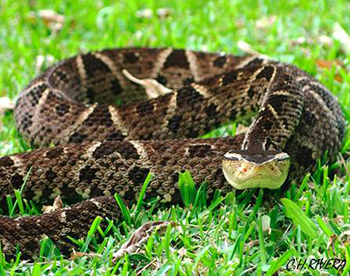Fer-de-Lance
Bothrops asper

Kingdom: Animalia
Phylum: Chordata
Subphylum: Vertebrata
Class: Reptilia
Order: Squamata
Suborder: Serpentes
Family: Viperidae
Subfamily: Crotalinae
Genus: Bothrops
Species: B. asper
Quick Facts:
The title “Fer-de-Lance” originally referred to the Martinique lancehead (Bothrops lanceolatus) found on the island of the same name in the West Indies. The common name has since been applied to the collective species of the Central and South American genus Bothrops. I decided to cover the Bothrops asper as this species is common in Belize. Belizeans refer to this snake as “Yellowjaw” or “Tommy Goff”. This snake is readily feared and has strong, fast-acting hemotoxic venom.
Description:
The Fer-de-Lance is easily distinguished as having a broad, flattened head set apart from the rest of their body. The ventral side of this species ranges from yellow to a white gray with dark spots frequenting the posterior end. The dorsal side can have a wide variety of colors (olive, gray, light brown, dark brown, tan, or nearly black) and displays lateral dark triangles with pale edges. This species is very sexually dimorphic and by 7 to 12 months after birth the females grow at a much faster rate. Adults are typically between 4 and 6 feet in length and can weigh up to 13 pounds. Although uncommon, females have been observed at lengths of 8.2 feet.
Habitat, Feeding, and Behavior:
The home rage of this viper extends from northwestern Mexico down to Ecuador where it primarily resides in tropical rainforests and tropical evergreen forests, but has commonly been found close to human habitations (theoretically due to its diet). This snake is nocturnal and hides during the majority of the day. Come nightfall, the Fer-de-Lance will feed primarily on agricultural pests. The juveniles have been noted to exhibit caudal luring to attract prey. This snake is known as being nervous and unpredictable. It is typically shy and will try to escape unless it feels cornered. Aggressive displays include vibrating its tail and enlarging its body to appear bigger. This snake can strike repeatedly and requires no fixed coil. The snake strikes at heat as well as movement and will often give a dry bite or partially envenomate the prey/threat.
Reproduction:
The reproductive cycle of this species varies depending on location and is related to rainfall patterns. Gestation time ranges from six to eight months and size of litter is directly related to female size. The male will make a series of movements and then slowly chase the female who stops movement and assumes position.
Conservation Status and Human Uses:
The Fer-de-Lance is not currently a species at risk. Human importance can be both positive and negative in nature. The positive importance is that the snake is helpful with pest control for farmers and the venom shows promising uses as a medicine or drug. The negative importance is the injury of humans due to bites which results in the most deaths by venomous snakes for its region.
Recent Research:
The majority of research being conducted on this species is related directly to its venom. There are many studies of the physiological effects of the venom on victims as well as reported research of a possible medicinal use of the venom; however I could not find any readily available studies relating to the medicinal aspects. The research indicates that the venom is fast acting with the main ill-effects beginning 3-6 minutes after the exposure. This data alerted researchers and scientists that the anti-venom need be administered early and must be able to rapidly diffuse into the cells.
Suggested Links:
Please note that the following links may have either been removed or relocated by the webpage owners since the time this student report was created.
http://reptile-database.reptarium.cz/species?genus=Bothrops&species=asper
http://www.tropicalherping.com/publications/books/mindo/bothrops-asper.html
References:
Please note that the following references may have either been removed or relocated by the webpage owners since the time this student report was created.
"fer-de-lance". Encyclopædia Britannica. Encyclopædia Britannica Online. Encyclopædia Britannica Inc., 2013. Web. 30 May 2013
<http://www.britannica.com/EBchecked/topic/75128/fer-de-lance>
“The Dangerous Snakes of Belize”. Consejo Belize, 2013. Web. 30 May 2013< http://consejo.bz/belize/snakes.html>
Sierra. 2003. “Captive Care of B. asper”. VenomousReptiles.org Resources. Web. 30 May 2013 < http://www.venomousreptiles.org/articles/133>
Brown, K. 2011. "Bothrops asper" (On-line), Animal Diversity Web. Accessed May 31, 2013 at http://animaldiversity.ummz.umich.edu/accounts/Bothrops_asper/
Lomonte, B., Lundgren, J., Johansson, B.,& Bagge, U. The dynamics of local tissue damage induced by Bothrops asper snake venom and myotoxin II on the mouse cremaster muscle: An intravital and electron microscopic study. Toxicon (32, 1) pp 41-45 (1994). http://dx.doi.org/10.1016/0041-0101(94)90020-5